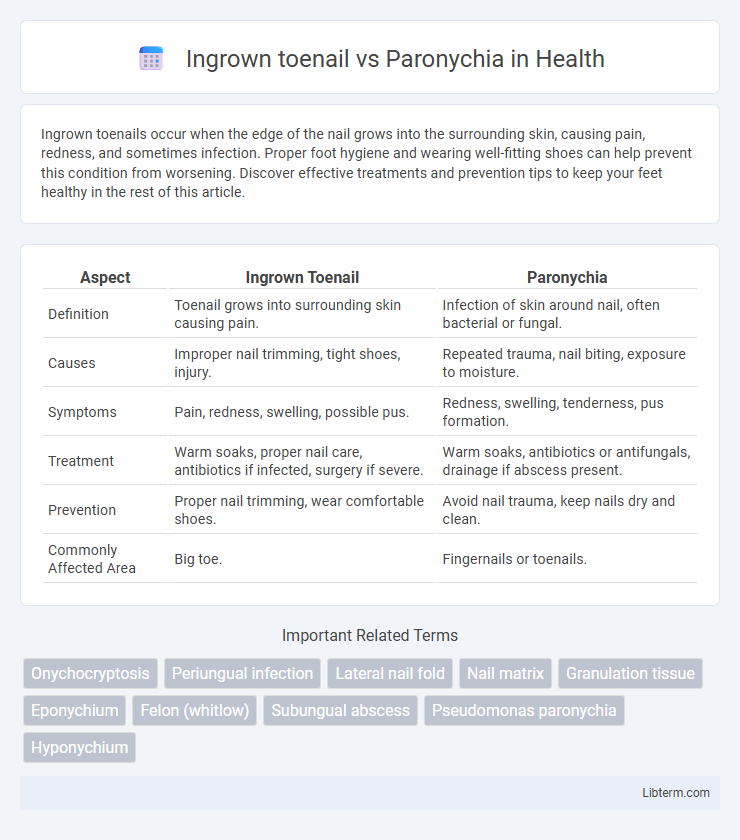Ingrown toenails occur when the edge of the nail grows into the surrounding skin, causing pain, redness, and sometimes infection. Proper foot hygiene and wearing well-fitting shoes can help prevent this condition from worsening. Discover effective treatments and prevention tips to keep your feet healthy in the rest of this article.
Table of Comparison
| Aspect | Ingrown Toenail | Paronychia |
|---|---|---|
| Definition | Toenail grows into surrounding skin causing pain. | Infection of skin around nail, often bacterial or fungal. |
| Causes | Improper nail trimming, tight shoes, injury. | Repeated trauma, nail biting, exposure to moisture. |
| Symptoms | Pain, redness, swelling, possible pus. | Redness, swelling, tenderness, pus formation. |
| Treatment | Warm soaks, proper nail care, antibiotics if infected, surgery if severe. | Warm soaks, antibiotics or antifungals, drainage if abscess present. |
| Prevention | Proper nail trimming, wear comfortable shoes. | Avoid nail trauma, keep nails dry and clean. |
| Commonly Affected Area | Big toe. | Fingernails or toenails. |
Understanding Ingrown Toenail and Paronychia
Ingrown toenail, known medically as onychocryptosis, occurs when the nail grows into the surrounding skin, causing pain, swelling, and potential infection. Paronychia is an infection of the skin around the nail, often caused by bacteria or fungi, resulting in redness, tenderness, and pus formation. Differentiating between an ingrown toenail and paronychia is critical for effective treatment, as ingrown toenails require nail edge management while paronychia often demands antimicrobial therapy.
Key Differences Between Ingrown Toenail and Paronychia
Ingrown toenail primarily occurs when the nail grows into the surrounding skin, causing localized pain, redness, and swelling, often affecting the big toe. Paronychia is an infection of the nail fold caused by bacteria or fungi, leading to pus formation, tenderness, and inflammation around the nail margin. While ingrown toenails are structural nail growth issues, paronychia is an infectious condition involving the soft tissue adjacent to the nail.
Causes of Ingrown Toenail
Ingrown toenails primarily result from improper nail trimming, tight footwear, or trauma to the nail bed, causing the nail edge to grow into the surrounding skin. This leads to localized pain, swelling, and potential infection if untreated. In contrast, paronychia is an infection of the nail fold usually caused by bacteria or fungi entering through a break in the skin near the nail.
Causes of Paronychia
Paronychia is primarily caused by bacterial or fungal infections following damage to the skin around the nail, often due to nail biting, manicures, or trauma. In contrast, an ingrown toenail results from the nail growing into the surrounding skin, leading to pain and inflammation without initial infection. Understanding the distinct etiologies is crucial for targeted treatment of these common nail disorders.
Common Symptoms: Ingrown Toenail vs Paronychia
Ingrown toenails commonly cause sharp pain, redness, and swelling along the nail edges, often accompanied by pus if infected. Paronychia typically presents with redness, tenderness, and swelling around the nail fold, sometimes with drainage of pus and a throbbing sensation. Both conditions feature inflammation and discomfort but differ primarily in the location and nature of the infection.
Risk Factors for Each Condition
Ingrown toenails develop primarily due to improper nail trimming, tight footwear, and repeated trauma to the toe, increasing the risk of the nail growing into the surrounding skin. Paronychia often arises from skin injuries near the nail fold, exposure to moisture, and chronic irritation, which facilitate bacterial or fungal infections. Both conditions are more common in individuals with diabetes or compromised immune systems, heightening susceptibility to complications.
Diagnosis: How Doctors Distinguish Them
Doctors distinguish ingrown toenails from paronychia by examining the location and type of symptoms: ingrown toenails typically cause localized pain and swelling along the nail edge due to nail plate penetration, while paronychia presents as soft tissue inflammation around the nail fold often with pus formation. Diagnostic techniques include physical inspection, where ingrown toenails show a nail edge buried in the skin, whereas paronychia reveals erythema, tenderness, and sometimes abscess near the nail margin. Swab cultures and imaging tests like X-rays are sometimes used to confirm infection or rule out complications in paronychia, but are rarely necessary for simple ingrown toenails.
Treatment Options for Ingrown Toenail
Treatment options for ingrown toenails primarily include conservative methods such as soaking the foot in warm water, using antibiotic ointments to prevent infection, and wearing properly fitting shoes to reduce pressure on the affected toe. In more severe cases, partial or total nail avulsion performed by a healthcare professional can alleviate pain and prevent recurrence. Surgical intervention may involve phenolization or matrixectomy to permanently remove the problematic nail edge and promote healthier nail growth.
Paronychia Management and Treatment
Paronychia management involves warm water soaks, topical or oral antibiotics targeting Staphylococcus aureus and Streptococcus species, and incision and drainage for abscess formation. Chronic paronychia treatment includes avoiding irritants, using topical antifungals, and corticosteroids to reduce inflammation. Early intervention and proper wound care are essential to prevent complications and promote healing.
Prevention Tips for Both Conditions
Maintaining proper foot hygiene and regularly trimming toenails straight across helps prevent ingrown toenails, while keeping the skin around nails clean and avoiding nail biting reduces the risk of paronychia. Wearing well-fitting shoes that do not compress toes can minimize pressure and trauma to the nail area, lowering the chances of both conditions. Avoiding aggressive nail care practices and promptly treating minor nail injuries supports overall toenail health and prevents infection.
Ingrown toenail Infographic

 libterm.com
libterm.com